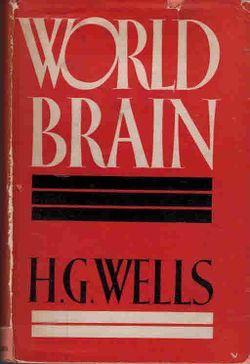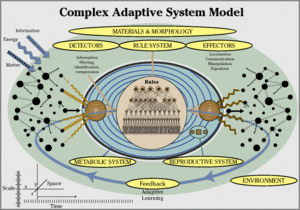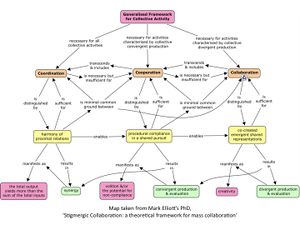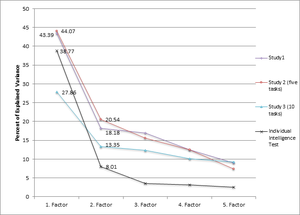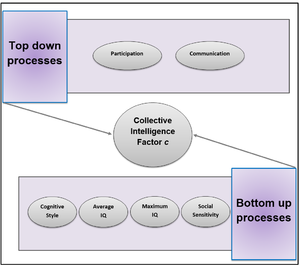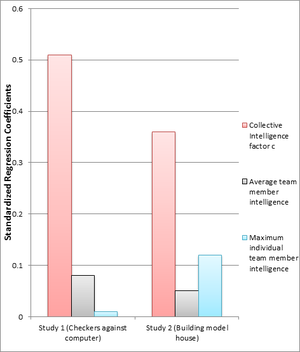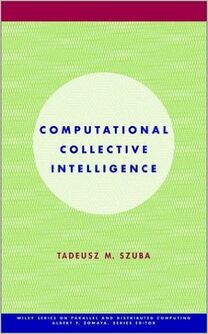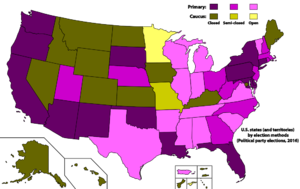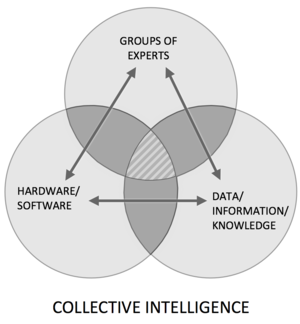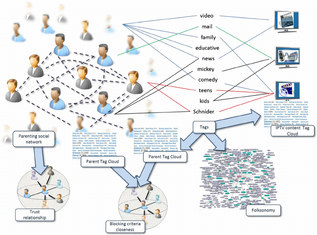集体智能
集体智能 Collective intelligence(简称CI,或称为 集体智力, 集体智慧等)指的是共享的或群体的智慧,源于众多个体的协作、共同努力和竞争,最终在决策中达到共识。其术语经常出现在社会生物学,政治科学以及大规模同行评议和众包应用中。它可能牵涉到 大众共识, 社会资本和形式体系,例如 投票系统,社交媒体和其他方式的群众活动。另一个概念是 群体智商 Collective IQ,它是用来度量集体智能的,尽管它通常会与集体智能一词互换使用。集体智能也可以在细菌和动物群体中形成。
以下三个要素在经过 协同作用后,产生的增效现象被理解为一种 涌现特性:
- 数据信息知识;
- 软硬件;
- 专家(具有最新见解且公认权威的专家)
通过不断从反馈中学习并产生实时性知识,这三个要素的 协同增效作用比它们单独采取行动来说,做出的决策会更好[1][2];或更狭义地讲,这是人与信息处理方式之间的一种涌现特性[3]。诺曼·李·约翰逊 Norman Lee Johnson将这种集体智能的概念称为 共生智能 symbiotic intelligence[4]。该概念用于社会学,商业,计算机科学和大众传播学:当然,它也出现在科幻小说中。皮埃尔·列维 Pierre Lévy给出了集体智能另一个定义:“它是一种普遍的分布式智慧,通过不断增强和实时合作来有效地调动技能。我将在此定义中添加以下必不可少的特征:集体智能的基本原则和目标是相互认可并实现个体自身的丰富,而不是什么拜物主义或者原质主义的邪教团体。”[5]根据研究人员ierre Lévy和德里克·德·科克霍夫Derrick de Kerckhove的说法,它指的是网络 ICTs(信息通信技术Information communication technologies)通过扩大人类互动范围来增强社会知识群体的能力。一个更广泛的定义是由 Geoff Mulgan 在一系列讲座和报告中提出的,从2006年开始,在阿德莱德系列讲座‘关于集体智慧和 http://www.thinkers.sa.gov.au/images/mulgan_final_report.pdf 的集体智慧’和在《 Big Mind Mulgan,Geoff Big Mind: How Collective Intelligence can Change our World 》一书中提出了一个分析任何思维系统的框架,包括人类和机器智能,在功能元素方面(观察,预测,创造力,判断等)。)、学习循环和组织形式。其目的是提供一种方法来诊断和改善一个城市、商业、非政府组织或议会的集体智慧。
集体智能极大地促进了知识和权力从个人到集体的转移。埃里克·雷蒙德Eric S. Raymond(1998)和杰西·赫兹JC Herz(2005)认为,相较于一个公司通过内部开发专有软件来创造知识,开源智慧则终将产生更优异的成果(Flew 2008)。媒体理论家亨利·詹金斯Henry Jenkins将集体智能视为与融合文化相关的“媒体力量的替代来源”。他提请人们关注教育,特别是基于传统教育设置之外的知识文化参与方式。Henry Jenkins批评学校提倡的“自主解决问题者和独立学习者”,同时又反对通过集体智能来学习[6]。Pierre Lévy(2007)和Henry Jenkins(2008)也都支持这样的说法,即集体智能对民主化很重要,因为它与以知识为基础的文化相互联系,并通过群体的思想共享来维持,从而有助于更好地理解多元化社会。
与测试个人智力的 g因子相似,对群体智力的最新科学理解主要是提取群体的综合智力因子”c因子”,以表明一个群体执行各种任务的能力[7]。其定义,操作方式和统计方法均同于 g因子测试法。同样地,由于g与IQ的概念高度相关[8][9],因此这种群体智力的度量也可以解释为 群体的智商(Group-IQ),即使该分数自身不是商。另外,还研究c值的成因和预测其有效性。
集体智能可用于帮助创建广为人知的平台,包括Google,Wikipedia和政治团体。Google就是主打搜索引擎的例子,它可以看作是由世界各地的人们共同创建数百万个网站的集合。它能够通过彼此共享知识和创造力,来协作并拓展思维与表达。Google团队包含五大关键动力,以创建一个协作良好的系统。它们是:心理安全性,可靠性,架构和清晰度,工作的含义以及工作的影响。他们重新发现集体智能的核心价值其实是确保所有员工都能够表达自己的意见,而不必担心其带来的尴尬。据说Google的团队合作是其成功的主要原因之一,其中包括运用情绪管理和集体智能来确保合作团队能参与任何讨论。Google背后的系统例证了网络与人知识的结合,而不仅仅是人与人知识的结合。
影响集体智能思想的作家包括弗朗西斯·加尔顿Francis Galton,道格拉斯·霍夫斯塔特Douglas Hofstadter(1979),彼得·罗素Peter Russell(1983),汤姆·阿特利Tom Atlee(1993),Pierre Lévy(1994),霍华德·布鲁姆Howard Bloom(1995),弗朗西斯·海里根Francis Heylighen(1995),道格拉斯·恩格巴特Douglas Engelbart,路易·罗森伯格Louis Rosenberg,克里夫·乔斯林Cliff Joslyn,罗恩·丹博Ron Dembo,戈特弗里德·梅耶·克雷斯Gottfried Mayer-Kress(2003)。
历史
这个概念(尽管没有如此命名)起源于1785年的侯爵·孔多塞Marquis de Condorcet,其 陪审原理指出,如果一个投票组的每个成员更有可能做出正确的决定,则该组中最高的票数是正确决定的概率会随着该组成员的数量增加而增加(请参考Condorcet's jury theorem 孔多塞陪审团原理.)。许多理论学家已经解释了亚里士多德 Aristotle在他的著作《政治》中的说法,即“集体盛宴相比较独自晚餐更加美味”,意思是每个人都可以带来各自的菜肴摆在餐桌上.。引申为许多人可能会提供不同的信息片段以产生更好的决策。然而,最近的一项研究表明,这可能不是亚里士多德的原意,而是根据目前我们对团队智能的了解做出的现代解释。
一开始昆虫学家威廉·莫顿·惠勒William Morton Wheeler意识到了这一概念(1910),他观察到独立的个体之间可以紧密合作,以至于无法与某单个生物区分开[10]。他在蚂蚁身上看到了这种协作过程,它们就像野兽的细胞一样,他称其为 超有机体。
1912年,埃米尔·涂尔干Émile Durkheim将社会定义为人类逻辑思维的唯一来源。他在《宗教生活的基本形式》一书中指出[11],社会构成了一种更高的智慧,因为它在时空上超越了个人。其他先例还有弗拉基米尔·韦尔纳斯基Vladimir Vernadsky和皮埃尔·泰尔哈德·德·夏尔丁Pierre Teilhard de Chardin的 智能圈概念以及赫伯特·乔治·威尔斯H.G. Wells的“ 世界脑World brain”概念(另请参见“ 全球大脑 Global brain“)。Peter Russell,伊丽莎白·萨赫图里斯Elisabet Sahtouris和芭芭拉·马克思·哈伯德Barbara Marx Hubbard( 意识演化一词的发起者)受到了 智能圈的启发,即超自然的,迅速发展的集体智能,相当于地球的大脑信息皮质层。哲学家Pierre Lévy最近对该概念进行了研究[12]。在1962年的一份研究报告中,Douglas Engelbart将集体智能与组织有效性联系起来,并预测说,积极地“增强人类智慧”将在解决群体问题方面产生事半功倍的效果:“以这种增强模式工作的三个人在解决复杂问题上的效率似乎是一个单独工作的人(同等增强幅度)的三倍以上”[13]。1994年,他创造了 群体智商一词来衡量集体智能,以集中精力在商业和社会中寻找显著提高群体智商的机会[14]。
集体智能的概念也构成了当代民主理论的框架,这些理论通常被称为 认知民主Epistemic democracy。指的是民众的能力,即通过审议或汇总知识来追踪真相,并依靠这种机制来综合运用集体智能[15]。
集体智能在20世纪后期被引入机器学习社区[16],后被广泛认作为一种方法,即如何设计自利的自适应主体“群落”来满足系统范围内的目标要求[17][18]。这与有关“奖励设计”的单主体工作有关[19],并已被博弈论和工程界的许多研究人员所推广[20]。
维度
Howard Bloom曾讨论过大众行为(从夸克到细菌,植物,动物和人类社会的群体行为)。他强调说,生物适应性使得地球上大多数生物已经变成了所谓的“学习机器”。1986年,Bloom将 细胞凋亡Apoptosis, 并行分布处理Parallel distributed processing, 群体选择Group selection和 超有机体Superorganism的概念结合在一起,产生了关于集体智能如何运作的理论。后来,他展示了如何用计算机生成的 复杂自适应系统Complex adaptive systems和 遗传算法Genetic algorithms( 由约翰·霍兰德John Holland所开创的概念)来解释竞争性细菌群落和人类社会的集体智能。
Bloom追溯了10亿年前我们细菌祖先集体智能的演变过程,并展现出自生命开始以来多物种智慧是如何发挥作用的[21]。类似蚂蚁社会在技术层面上,表现出了比人类社群以外的任何动物更多的智慧。它们合作饲养牲畜,例如“挤奶”的蚜虫[22]。切叶蚁负责护理真菌,并用叶子喂食真菌[23]。
大卫·斯科宾纳 David Skrbina 引用了 群体心智(Group mind)的概念[24],该概念源自柏拉图的 泛心论 Panpsychism(即思想或意识无所不在,并存在于所有事物中)。他进一步发展了托马斯·霍布斯Thomas Hobbes在 利维坦中表达的“群体意识 collective consciousness”的概念[25],以及费希纳关于人类集体意识的论点。他认为Durkheim是“集体意识”最著名的拥护者,并且认为Teilhard de Chardin作为思想家,曾提出了 群体心智(Group mind)的哲学含义[26]。
Tom Atlee则主要关注人类,以及如何提升Howard Bloom所说的 群体智商。Atlee认为,可以鼓励集体智能去“克服‘群体思维'和个人的认知偏见,以使集体在一个过程中进行合作,同时产生更高的智力表现。”乔治·珀尔George Pór将集体智能现象定义为一种能力,即“人类社区通过差异化,融合,竞争和协作等创新机制,向更高层次复杂性协调发展”[27]。 Atlee和Pór指出“集体智能还涉及实现注意力集中和度量标准的统一,从而提供适当的行动阈值”[28]。 他们的方法植根于科学共同体的隐喻[29]。
术语 团体智慧Collective intelligence有时可以与 集体智能Collective intelligence一词互换使用。安妮塔·伍利Anita Woolley认为集体智能,可以衡量集体智慧和创造力[30]。即集体智能的度量能涵盖群体的广泛特征,主要包括群体组成和群体互动[31]。导致群体中集体智能水平提高的组成特征包括:群体中女性人数增加以及群体内多样性增加等[32]。
Atlee和Pór还认为,集体智能领域应首先被视为是全体人类的事业。尽管群体理论和人工智能可以提供一些帮助,但是当我们在这个巨大的公司内协作时,为了共同利益,观念模式、分享意愿,以及对分布式智能的开明尤为重要[33]。尊重集体智能的个体对自己的能力充满信心,并承认整体确实大于任何单个部分的总和[34]。最大化集体智能取决于组织接受和发展“黄金建议”的能力,即任何成员都可能提供有用的信息[35]。然而,若将输入限制为少数几个人,或过滤掉潜在的“黄金建议”,团体思考通常阻碍集体智能的发展和实施[36]。
罗伯特·戴维·斯蒂尔·维瓦斯Robert David Steele Vivas在《智慧前沿The New Craft of Intelligence》中将所有公民描绘为“情报干事”,描绘了仅利用法律和道德信息,就能够创造出使公共官员和公司经理保持诚信的“公共情报”,从而改变高层的“国家情报”(以前涉及间谍和保密系统)[37]。
根据唐·塔普斯科特Don Tapscott和安东尼·威廉姆斯Anthony D. Williams的说法,集体智能就是大规模协作。为了使这个概念成立,需要满足以下四个原则[38]:
Openness: Sharing ideas and intellectual property: though these resources provide the edge over competitors more benefits accrue from allowing others to share ideas and gain significant improvement and scrutiny through collaboration.
开放性
共享想法和知识产权:尽管这些资源为竞争者提供了优势,但允许其他人共享想法可以带来更多好处,并通过协作获得重大改进和审查。
Peering: Horizontal organization as with the 'opening up' of the Linux program where users are free to modify and develop it provided that they make it available for others. Peering succeeds because it encourages self-organization – a style of production that works more effectively than hierarchical management for certain tasks.
对等性
横向组织具有和Linux程序一样的“开放性”,用户在被允许的情况下,可以自由修改和开发该程序。这种对等性的成功是因为它鼓励自组织形式,这种形式的生产方式比某些任务的分层管理更有效。
Sharing: Companies have started to share some ideas while maintaining some degree of control over others, like potential and critical patent rights. Limiting all intellectual property shuts out opportunities, while sharing some expands markets and brings out products faster.
共享
一些公司已经开始分享他们的想法,但是同时又对其部分想法保持一定程度的控制,例如潜在的和关键的专利权。限制所有知识产权会失去一些机会,而共享则会扩大市场并更快地推出产品。
Acting Globally: The advancement in communication technology has prompted the rise of global companies at low overhead costs. The internet is widespread, therefore a globally integrated company has no geographical boundaries and may access new markets, ideas and technology.
全球行动
通信技术的进步以较低的间接成本促使了全球公司的兴起。互联网遍布全球,因此一家全球一体化的公司打破了地域限制,他们可以访问任何新市场,新思想和新技术。
集体智力因子c
对集体智能最新的科学理解,是将其定义为一个团队执行各种任务的综合能力。定义,可操作性和统计方法类似于G因素(心理测量学,常规个人智力的计量方法)。因此,在给定的一组认知任务上的个人表现被用于计量综合认知能力,通过因子分析法算出其智力因子g。同理,g用于表达认知任务与个体之间的表现差异,集体智能研究的目的是为群体“c因子”(也称为“集体智力因子”(CI))找到一个类似的智力因子,以显示任务表现上群体间的差异。然后,将集体智力得分用于预测该组将来执行其他类似任务的表现。然而,目前任务的内容设置还局限在针对小团体的心智任务,尽管一开始的概念是希望能涉及的更广泛,比如说从家庭到公司甚至整个城市的任何团体或人群。由于个体的 g因子得分与全方位IQ得分密切相关,并且后者还可以恰当的估计 g因子,因此集体智能测量的结果同样可以被视为是一个群体的智力指标或商(Group-IQ),类似于个人智商(IQ),虽然该分数本身不是商。
从数学上讲,c和g都是变量,假设不同团队或个人在不同任务(但相似)中的表现具有可比性,这两个变量均描述了该团队或个人在不同任务之间的正相关性[39]。因此,c表示的是团队之间的差异,在给定相关人口设置的其他组相比,它仅被视为该组在c因子上的设置结果[40][41]。g需要注意的是,该概念与竞争假设(包括其他可以解释群体智能的相关结构)形成对比[42],例如由个体人格研究中发现的一些同样重要但相互独立的因素组合[43]。
此外,这一科学思想还旨在探讨影响集体智能的原因,例如小组规模,协作工具或小组成员的人际交往能力。例如,麻省理工学院的集体智能中心宣布检测“集体智能的基因组”是其主要目标之一,旨在建立一种分类法,可以组织构建模块或基因组,并对其进行重组,以利用群体的智力[44]。
原因
个体智力受到遗传与环境影响。类似地,集体智力的研究目的是探索为什么某些群体比其他群体表现地更聪明,假设因子c与群体中单个成员的智力适度相关。根据Woolley等人的结果,团队凝聚力,动机或满意度都与因子c无关。但是,他们声称发现了三个非常重要的相关因素:成员发表意见的次数,成员社会敏感度平均值和女性比例。这三者对因子c具有相似的预测能力,但目前只有社会敏感度具有统计学意义(b = 0.33,P = 0.05)。
成员发表意见的次数表明“由少数人主导的群体,其集体智力不及那些对话轮流分配更为平均的群体。”[45]因此,为多个团队成员提供发言的机会可以让团队更加聪明[46]。
小组成员的社交敏感度通过“ 眼神阅读测试Reading the Mind in the Eyes Test”[46](RME)并与c关联(0.26)[47]或 读心术进行测量。这里要求参与者检测图片中呈现的其他人眼中表达的思维或感觉,并以选择题形式进行评估。该测试旨在衡量人们的 心智理论Theory of mind(ToM),也称为“心理化”[48][49][50][51]或“思想阅读”[52],指的是感受他人心理状态的能力(例如信念,欲望或意图),当他们的信念,欲望,意图或观点与自己有所不同时,能在多大程度上理解他人。RME是针对成人的ToM测试,显示出足够的重测信度,并不断将对照组与患有功能性自闭症或阿斯伯格综合症[53]的个体区分开来。它是成人ToM最广泛接受和验证良好的测试之一[54]。在更宽泛的情商概念中,ToM可被视为技能的相关子集[55][56]。
女性占比作为因子c的预测因素主要是通过社会敏感性介导(Sobel z = 1.93,P = 0.03)[57],这与之前的研究结果相符,即女性在社会敏感性测试中得分更高[58]。从统计学上讲,介导,从统计学上讲,澄清了因变量和自变量之间关系的基本机制[59]。伍利在接受《哈佛商业评论》采访时曾表示这个发现说明了女性群体比男性群体更聪明。但是,她也就这个结论做了相对化的陈述,实际上重要的是团体成员的高度社会敏感性[60]。
从理论上讲,集体智力因子c是由自下而上和自上而下共同产生的 涌现特性。因此,自下而上的过程涉及聚合组成员的特征,自上而下的过程涉及团队结构,以及协作协调方式对团队风格的影响[61]。
处理程序
自上而下
自上而下的处理包括团队交互分析,涉及例如结构,程序和规范[62]。这种自上而下的过程的一个例子是话轮转换机制。研究进一步表明,集体智慧的群体大体上能进行平等地交流。此过程同样适用于参与形式的沟通,类似面对面以及通过书面形式进行的在线小组交流[63][64]。
自下而上
自下而上的处理包括小组组成分析,即小组成员的特征,这些特征汇总直接影响到团队级别[65]。例子之一包括社会敏感度平均值或小组成员的平均和最大智力得分。此外,人们发现集体智能与一个群体的认知多样性有关,包括思维方式和观点[66]。认知风格适度的群体,相比较认知风格非常相似或非常不同的群体,具有更高的集体智能。因为成员彼此之间过于相似会造成该群体缺乏不同的观点(往往团队任务表现好的具有各种观点)和技能。另一方面,成员差异太大的团体可能会难以有效地沟通和协调[67]。
串行与并行
在大多数人类历史中,集体智能都局限于少数部落群体,它们通过成员之间的实时并行互动来收集意见。而现代,因为大众传播,媒体和网络技术的发展使集体智能可以跨越各大洲和时区,这是一个极其庞大的群体。为了适应规模上的这种变化,大规模集体智能被序列化投票过程所控制,例如随着时间的推移去汇总投票,赞赏和评级。在工程领域中,汇总各种工程决策可以识别分析优秀的经典设计[68]。尽管现代系统受益于更大的群规模,但事实上发现串行化处理过程会引入大量噪声,从而使群组的集体输出失真。在一项有关序列化集体智能的重要研究中发现,对序列化投票系统做出贡献的第一票可能使最终结果失真34%[69]。
为了解决大规模群体之间因为输入序列化汇总的问题,目前的进展是,集体智能已经淘汰了序列化的选票,民意测验和市场,进而采用了以自然群体为蓝本的并行系统,例如“人类集群Human swarms”[70][71]。基于 群体智能Swarm Intelligence(注意区分Collective intelligence)的自然执行过程,这些由人类联网组成的人工集群使参与者可以并行工作来解决问题,并为涌现集体智能做出预测[72]。在一个引人注目的示例中,CBS Interactive(美国著名媒体公司)进行了人类集群的挑战以预测肯塔基德比(美国著名跑马赛)。这群人正确地预测了前四匹马,顺次击败了542-1的赔率,将20美元的赌注变成了10,800美元[73]。
斯坦福大学医学院和Unanimous A.I.的研究人员证明了在医学应用中并行集体智能的价值,在已发表的研究中,它们采用了实时集群算法将一组人类医生联系在一起,运用胸部X射线来诊断肺炎的存在[74][75]。当作为“人类集群”一起工作时,经验丰富的放射科医生小组相比较传统方法,诊断错误减少了33%.[76][77]。
证据
伍利,察布里斯,彭特兰,哈什米(2010)是集体智能这一科学概念的创始人[78]。他们在192个群体的研究中发现了集体智能的单一统计因子,这192个群体的成员均是从公众中随机招募的。研究中,每个组群都是基于 麦格拉思任务环McGrath Task Circumplex(一种完善的小组任务分类法)[79]进行合作。这些任务是从四个象限中选择的,包括视觉难题,头脑风暴,集体道德判断以及就有限的资源进行谈判。将这些任务中的结果用于因子分析。两项研究均显示出了综合集群智力因子c的特征,并且根据群体的不同表现出了一定的差异,其初始特征值约占这些差异的43%(研究2中为44%),而另一个因子仅占18%(20%)。该数据与综合个体智力因子g的范围相符,通常在认知测验中占个体间性能差异的40%至50%[80]。
后来每个小组进行测试,验证提取c因子是否具有预测原始任务以外的能力,进而解决了更为复杂的判据任务。在第一个研究中,判据任务是在标准计算机上玩跳棋(国际跳棋),在第二个研究中则是复杂的建筑设计任务。在使用组员个人智力和c因子来预测判据任务执行情况的回归分析中,c具有显著作用,而平均和最大的个人智力则没有。虽然单个组成员的平均智力(r = 0.15,P = 0.04)和最高智力(r = 0.19,P = 0.008)与c有中等程度的相关性,但是c仍然是判据任务更好的预测指标。根据伍利等人的说法,该结果支持了集群智力因子c的存在,因为它证明了超出小组成员个人智力外的影响,因此c不仅仅是个人智商的累加,或单纯受到智商最高组员的影响[81]。
恩格尔等人的研究(2014)在重复了伍利组员之前的研究发现[82],将加速任务组合与因子分析中的第一因素结合在一起,可以解释组间表现差异的49%,而其他因素解释占该比例一半以下。此外,他们在仅通过文本进行在线交流的小组中发现了相似的结果,并证实了女性比例和社会敏感性在两种情况下引起集体智能的作用[83]。他们还模仿伍利小组使用RME来衡量社会敏感度,为了衡测试者感受他人眼中心理状态的能力。但是,在线合作参与者根本不认识也不见面。作者得出的结论是,RME的分数必须与更广泛的社会推理能力相关,而不仅仅是从其他人的眼神表情中得出推论[84]。
伍利他们进一步在MBA学生群体中(时间跨度为一学期)[85],在线游戏玩家群体中以及来自不同文化和不同背景的其他群体中(时间跨度分别为短期和长期组)发现了集体智力因子c。这些调查均未将团队成员的个人智力得分视为控制变量[86][87][88]。
注意的是,集体智能研究领域仍处在初始阶段,而且公开的经验证据还很少。各种提议和文章正在进行或已经完成,但(据说)仍处于学术同行评审出版过程中[89][90][91][92]。
预测有效性
集体智力因子c除了能预测团队在判据任务(初始实验中相对较复杂任务)上的表现外,还能够预测持续数月的MBA课程中各种任务的团队绩效[93]。因此,尽管组员在其他单独执行任务上没有做得很好,但具有高度集体智能的小组在团队任务上得分明显更高。此外,具有高度集体智能的团队会随着时间推移逐渐提高能力,这表明团队智力的集合性越高,其本身的学习能力约好。这类似于个人智力的性质,即聪明人越多,团队可以更快地获取新材料[94][95]。
个体智力可以用来预测从学业事业的成功到健康甚至死亡的大量生活场景[96]。除了在智力任务上的表现外,集体智能是否能够预测其他结果尚待研究。
与个人智力的潜在联系
格拉德威尔Gladwell(2008)[97]指出,个人智商与成功之间的关系仅在一定程度上起作用,而且智商超过120以上的其他智力点并不能转化为现实生活中的优势。是否Group-IQ存在相似的边界?或者优势是线性的和无限的?这仍然有待探索。同样,对个人智力和集体智力之间的联系也需要进一步探究,是否存在个人智力其他潜在因素可以转移到集体智力中?例如随着时间的推移自我进化或智力提高[98][99]。尽管目前对于是否能通过培训来增强人类智力这一论点存在争议,但一个团队的集体智力是可以潜在性地通过交换组员或实施结构和技术上的提升来改进的。此外,人们发现阅读文学小说[100]以及看戏曲电影[101]至少可以暂时改善社会敏感性。但是社会敏感性培训最终是否能提高集体智力以及在多大程度上提高集体智力,这仍然是一个悬而未决的问题[102]。
还有更多更高级的概念和因子模型试图解释个体的认知能力,包括流体智力和晶体智力[103][104]或智力差异的分层模型.[105][106]。但是,除了通用的“c因子”外,目前并没有对集体智力基因组的因子结构采取进一步补充说明和概念化[107]。
争议
有的学者通过将团队成员的综合智力进行汇总到团队级别来解释团队能力,而不是建立团队自身的集群智力指标[108][109]。迪瓦恩Devine和飞利浦Philips(2001)在一项Meta综合分析中表明[110],认知能力可以预测团队在实验室环境(.37)和现场环境(.14)中的表现,但是请注意,这只是很小的影响。其他学者认为这相当依赖于不同的相关任务,他们表示那些需要高度沟通与合作的任务其实受认知能力最低组员的影响最大[111]。因此选择最佳组员是成功的关键策略,这些任务受认知能力最高的成员影响最大[112]。
由于伍利等人的结果并未显示出团队满意度,团队凝聚力或动机的任何影响,因此他们仅隐含地挑战了这些观点,并表示了其总体上对团队绩效的重要性。通过Meta综合分析,他们证明了团队凝聚力[113][114][115],动机[116][117]和满意度[118]对团队绩效的积极影响。
值得一提的是,确认结果中涉及的研究人员之间,以及与参与有关Anita Woolley最初第一项研究的作者之间也存在广泛的重叠[119][120][121][122][123]。
其他数学替代技术
计算集体智能
2001年,来自波兰AGH科技大学的Tadeusz(Tad)Szuba提出了一种具有集体智能现象的正式模型。模型假定是一个无意识,随机,并行和分布式的计算程序,其社会结构以数学逻辑方式运行[124]。
在此模型中,将真实环境中的生物和信息两部分进行建模,表示为带有数学逻辑表达式的抽象信息分子。由于它们与环境之间的相互作用,以及它们自身带有的目标位移属性,会准随机地进行挪动。随后,它们会在抽象的计算空间中交互,进而创建多线程推导处理程序,其过程则被视为集体智能。因此,非图灵计算模型被采用。该理论将集体智能简单定义为社会结构的属性,而且似乎对于各类生物(从细菌菌落到人类社会结构)均适用。集体智能被视为是一种特定的计算过程,它为几种社会现象提供了直接的解释。对于这种集体智能模型,科学家们提出了IQS(即IQ社会)的正式定义,并将其定义为“在时间和N元素推理域(反映社会结构推理活动)上的概率函数”。IQS在计算上似乎很难,但是根据如上所述的计算过程对社会结构进行建模的话,可以得到近似的结果。通过最大化IQS,公司可以优化其潜在的应用,另外医学上,也可以对细菌菌落的集体智能进行建模,来分析耐药性。
集体智商
有时候我们会采用另一种度量方式表达,称为“ 集体智商Collective intelligence quotient” (或“ 合作商Cooperation quotient”)[125],它特别受到以人工智能为研究重点的理论家的青睐。它可以由“个体”智商归一化处理后得到。因此可以进一步确定参加集体行动的新增组员所带来的额外边际智商,还可以使用度量标准来避免由群体愚蠢思维带来的危险[126]。
应用
集体智慧最近有许多应用,包括在众包、公民科学和预测市场等领域。内斯塔集体智慧设计中心[127]于2018年成立,已经完成了许多申请调查以及资助实验
评估点提取
关于集体智能,其应用目标之一是获得某个变量的估计值(单个值)。例如估算物体的重量,产品的发布日期或项目成功的概率等。其应用场景可以是在Intrade,HSX或InklingMarkets等预测市场中,亦或在对数字结果进行众包估计的几种实操过程中。从本质上讲是尝试获取指定群体中成员提供的估计平均值。
意见汇总
在这种场景下,集体智能可用于收集人群中相关的不同想法,问题或产品的意见。例如,尝试对在线销售的产品(例如亚马逊的星级评分系统)进行某种程度的评级。这里重点是收集并简单地汇总客户/用户提供的评级。
想法收集
在处理问题的时候,集体智能也可以用于从人群中收集相关项目的想法,设计或解决方案。例如,关于解决数据科学问题的想法(类似在Kaggle中),获得T恤衫良好设计的想法(类似在Threadless中),或者收集仅人类能处理的简单问题的答案(类似在Amazon的Mechanical Turk中)。这里的目标是收集各种想法并设计选择标准来从中筛选出最佳方案。
纽约客商业专栏作家詹姆斯·苏洛维奇James Surowiecki将无组织决策的优势分为三个主要类别,即认知,合作和协调[128]。
认知
市场判断
由于英特网具有在全球范围内快速传递大量信息的能力,因此使用集体智能来预测股票价格和股票价格方向已变得越来越可行。网站汇总了尽可能最新的股票市场信息,以便专业或业余股票分析师可以发布其观点,从而使业余投资者可以提交其金融见解并创建汇总意见[129]。这些投资者的意见可以加权平均,以便将有效地运用集体智能作为关键前提:利用群众,包括广泛的股市专业知识,来更准确地预测金融市场的行为[130]。
集体智能巩固了尤金·法玛Eugene Fama的有效市场假说[131],尽管集体智能这个词在他的论文中并未明确使用。法玛引用了迈克尔·詹森Michael Jensen的研究,在1955年至1964年期间,115个精选基金中有89个相对于该指数表现不佳。但是,在取消了加载费用(前期费用)之后,只有72个基金表现不佳,而在去除经纪费用之后,剩下了58个。在这些证据的基础上,指数基金成为了市场投资工具,使用市场的集体智能而不是专业基金经理的判断作为投资策略[132]。
政治和技术预测
政党动员了大量人力制定政策,选拔候选人和资助并开展竞选活动[133]。通过各种投票方法集中信息,使观点融合假设,不知情者的投票在某种程度上可视为是随机的,可以从决策过程中过滤掉,仅留下有共识的知情者的投票。批评家指出,坏主意,误解和谬见通常会广泛存在,因此决策过程的结构必须有利于那些在给定背景下,不大可能出现随机或者误导投票的专家[134]。
诸如Affinnova(被尼尔森收购),Google,InnoCentive,Marketocracy和Threadless[135]等公司已经成功地采用了集体智能的概念[136],通过其研发(R&D),客户服务和知识管理实现了下一代技术变革。这种应用的一个例子是2012年谷歌的亚里士多德项目,在该项目中,集体智慧对团队组成的影响在数百个公司的研发团队中进行了研究。
合作
信任网络
2012年,千年计划创建了 全球集体智能系统Global Futures Collective Intelligence System(GFIS),因为它将数据/信息/知识,软件/硬件以及技术/见解进行了协同处理,使其成为了集体智能最贴切的代表。与单独的各项参与模块相比,它具有递归学习的处理能力,可以更好地进行决策。
另外新媒体也可以促进增强集体智能。其通过数据库和英特网轻松存储和检索信息的能力使得信息共享毫无困难。因此,通过与新媒体的互动,知识很容易在资源之间传递(Flew 2008),从而形成了集体智能。交互式新媒体(尤其是互联网)的使用促进了在线互动以及用户之间的知识分配。
弗朗西斯·海里格森Francis Heylighen,瓦伦丁·图尔钦Valentin Turchin和Gottfried Mayer-Kress都是通过计算机科学和控制论的视角看待集体智能。他们认为,互联网可以在最广泛的地球尺度上实现集体智能,从而促进全球大脑的出现。
万维网创始人蒂姆·伯纳斯·李Tim Berners-Lee,曾以促进全球信息共享和发作为目标开发了万维网。后来,他的雇主开放了该技术以供大家免费使用。在90年代初期,互联网的潜力一直没有得到开发,直到1990年代中期,高级研究计划局(ARPA)负责人J.C.R. Licklider博士将其称为“临界质量”,并要求其具有更强的可访问性和实用性[137]。这种基于互联网的集体智能驱动力是信息和通信的数字化。研究新媒体出现和媒体融合的关键理论家Henry Jenkins借鉴了其概念,认为集体智能可以归因于媒体融合和参与性文化(Flew 2008)。他批判当代教育未能将集体智能理念的趋势纳入课堂,比如说可以通过在线集群智慧解决问题这一思想。并指出“通过集体智能社区鼓励以集体为单位进行工作学习,而学校则需要对个人评分”。詹金斯认为,知识社区内的互动为年轻人创造了至关重要的技能,而通过集体智能社区的团队合作则有助于此类技能的发展。集体智能不仅是来自所有文化信息的定量贡献,同样也是定性存在。
莱维Lévy和德克霍夫de Kerckhove从大众传播的角度考虑了CI,特别是专注用网络信息和通信技术来增强社区知识库的能力。他们认为,这些通信工具可以使人们能够轻松快捷地进行交互,共享和协作(Flew 2008)。随着互联网的发展及其广泛使用,为诸如Wikipedia之类的知识社区做出贡献的机会比以往任何时候都要大。这些计算机网络使参与活动的用户有机会通过对这些数据库的集体式访问来存储和检索知识,同时还允许他们“驾驭蜂巢”,这是麻省理工学院集体智能中心的研究人员的任务,它们一直在探索人和计算机群体的集体智能[138]。
在这种情况下,集体智能常常与共享知识相混淆。前者是社区成员单独持有的信息的总和,而后者是社区所有成员都认为是真实且已知的信息[139]。以Web 2.0为代表的集体智能比协作智能具有更少的用户参与度。使用Web 2.0平台的艺术项目“共享银河”,是一个由匿名艺术家开发的实验,目的是创建一个集体身份,并在MySpace,Facebook,YouTube和Second Life等多个平台上以这个集体身份出现。密码将写在配置文件中,并且名为“ Shared Galaxy”的帐户开放给任何人使用。通过这种方式,许多人成为一体。Curatron是另一个利用集体智能创作艺术作品的艺术项目,其中一大批艺术家共同决定建立一个较小的团队,他们对其团队的协作表现非常自信。该项目基于一种计算集体偏好的算法。在创建他所谓的“ CI艺术”时,新斯科舍省的艺术家马修·阿尔德雷德Mathew Aldred遵循了皮耶·列维对集体智能的定义[140]。2016年3月,奥尔德雷德的CI-Art活动吸引了来自牛津,新斯科舍省和全球的400多人参加。奥尔德雷德后来开发的工作使用联合国大学群体智能系统来创建数字绘图。牛津河畔画廊(新斯科舍省)于2016年5月举办了一次公共CI艺术活动,与国际在线参与者建立联系[141]。
在社交书签(也称为协作标签)中,用户将标签分配给与其他用户共享的资源中,继而从这种众包过程中产生了一种信息组织。最终的信息结构可以看作反映用户社区的集体知识(或集体智能),通常被称为“大众分类”,这个过程可以通过协作标记模型来捕获。
近期,通过对社会书签网站Delicious的数据的研究表明,协作标签系统表现出一种复杂的系统(或自组织)动态形式。尽管没有中央控制来约束单个用户的操作,但是不同资源标签的分布已显示出会随着时间推移,逐渐收敛到稳定的幂律分布[142]。一旦这种稳定的分布形成,就可以利用不同标签之间的相关性来构建简单的大众分类图,进而可以对其有效的划分,以获得社区或共享词汇表的形式[143]。这些词汇可以看作是集体智能的一种形式,它源于用户社区的分散行动。Wall-it项目也是社交书签的一个示例[144]。
P2P业务
Tapscott和Williams进行的研究提供了一些示例,说明了集体智能对企业的好处[145]:
- 人才利用
随着技术发展速率的变化,没有一家公司能够完全跟上竞争所需的创新。相反,聪明的公司正在利用大规模协作的力量来吸引他们无法雇用的人员。这也有助于公司持续地有兴趣去吸引新创意和投资机会的出现。
- 需求创造
企业可以通过参与开放源代码社区来创建互补商品的新市场。即使没有社区的资源和协作,企业也可以扩展到以前无法实现的新领域。如前所述,这为所述新领域中商品的互补产品创造了新市场。
- 降低成本
大规模协作可以帮助大幅降低成本。公司可以发布特定软件或产品,以供在线社区进行评估或调试。最终将会在较短的时间和成本下生产出更具个性化,功能强大且无失误的产品。在线社区的协作也可以产生和探索新的想法,从而为公司范围之外的免费研发创造机会。
开源软件
文化理论家和在线社区开发人员约翰·班克斯John Banks考虑在线粉丝社区对Trainz产品创作的贡献。他认为,其商业上的成功从根本上取决于“一个活跃在线粉丝社区的形成和发展,既可以积极地推广该产品,也可以为游戏软件创建内容扩展”[146]。
随着用户创建的内容和用户之间的交互性持续增加,会引发了对游戏自身和玩家的控制权问题,因为大量内容是由玩家创造。lessig[147],Bray和Konsynski[148]对此列出一系列相关法律问题,例如知识产权和财产所有权。
戈斯尼Gosney在他对替代现实游戏的讨论中,将集体智能扩展到了电子游戏中。他将这种类型描述为“一种跨媒体游戏,故意模糊游戏内体验与游戏外体验之间的界线”[149],因为发生在游戏现实之外的事件会“渗透”到玩家的生活中。为了使他们在一起。游戏需要“多个玩家的集体和协作”;因此,集体和协作团队合作的问题对于ARG至关重要。戈斯尼认为,游戏的替代现实类型要求了前所未有的协作水平和“集体智慧”,以解决游戏的奥秘。
合作受益
合作有助于解决最重要且最有趣的多学科问题。詹姆斯·苏洛维奇James Surowiecki在他的书中提到,大多数科学家认为与潜在成本相比,合作带来的益处具有更大的价值。合作之所以有效,是因为它保证许多不同观点的存在。如今由于技术带来的可能性越来越大,全球合作比以往更加容易而且富有成效。显然,合作从学术研究延申到了全球合作实践,此时它会带来的收益将越来越重要。
例如,科学家为什么要合作?科学变得越来越孤立,因为每个科学领域的传播越来越广泛,一个人不可能意识到所有的发展。尤其是需要特殊技能的实验研究,因为高度先进的设备操作需要一定的知识背景。通过合作,科学家们可以利用不同领域的信息并有效地利用它,而不仅仅是靠自己阅读来收集所有信息[150]。
协调
临时社区
军事,贸易协会和公司一定程度上都满足CI的某些定义,其最严格的定义是要求能够对任意条件做出响应反馈,而不须要“法律”或“客户”的命令或指导来限制行动。在线广告公司正在利用集体智能绕过传统的营销和创意代理[151]。
联合国大学的“人类集群”(或“社会集群)开放平台,围绕生物集群网络用户建立了实时闭环系统,使人类参与者能够模拟集体智能一样行动。当连接到联合国大学后,成群的散户共同回答问题并实时做出预测[152]。早期测试表明,人类集群可以预测个体。2016年,一名记者向联合国大学群发起挑战,以预测肯塔基德比的获胜者,并成功选出了前四匹马,以540比1的优势胜出。
诸如Digital Photography Review或Camera Labs之类的专业信息网站就是集体智能的一个例子。任何可以访问互联网的人都可以通过专门的信息站点为世界范围内传播知识做出贡献。
在“学以创用环境 Learner-generated contexts”下,一组用户调配资源以创建其生态来满足它们的需求(但不仅如此),即特定学习空间的共同配置,创造和设计。它们允许学习者创建自己的环境[153][154][155]。“学以创用环境”代表一个特设社区,可促进在信任网络中协调集体行动。当协作用户在“共享智能空间”中的汇总知识时,可以在互联网上找到学习者生成的具有上下文的一个示例。随着互联网的发展,CI作为共享论坛的概念也不断发展。互联网的全球可访问性和可使用性比以往任何时候都更欢迎群众贡献和获取想法。(2008年Flew)
- RIcky:不明白为什么Learner-generated contexts 翻译成 学以创用环境
《模拟人生》系列和《第二人生》等游戏的设计是非线性的,并依靠集体智能进行扩展。这种共享方式会自我进化,并同步影响当前及未来新生代产品的思维方式。对于他们来说,集体智能已经成为了一种常态[156]。在特里·弗尔Terry Flew关于对网络游戏环境“交互性”的讨论中(即用户与游戏开发人员之间的交互对话)[157],他提到了Pierre Lévy的“集体智能”概念(Lévy 1998),并认为这在电子游戏中非常活跃,就像是MMORPG中的部族或公会一样,会不断努力去实现目标。Henry Jenkins提出,游戏生产商,媒体公司和终端用户之间形成的参与式文化,标志着媒体的生产消费性质在根本性转变。詹金斯认为,这种新的参与式文化源于三大新媒体趋势的交融[158]。首先,开发的新媒体工具/技术促使内容的创建。然后亚文化的兴起促进了这种创造,最后,增值媒体集团壮大了形象,思想和叙事的传播。
协调集体行动
即兴表演也相当于一种集体智能,他们称之为“集体思维”,因为戏剧即兴表演依靠演员相互合作并达成共识,从而导致“集体思维”的统一。
互联网和移动电信的发展也产生了“聚集”或“约会”的事件,这些事件使即时会议甚至约会成为可能[159]。反全球化运动目前尚未产生全面的影响,但是它在很大程度上依赖于电子邮件,手机,传呼机,SMS和其他组织方式。Indymedia组织以更具新闻性的方式进行此操作。这些资源可以合并为仅对当前参与者负责的集体智能形式,但需要几代贡献者提供强有力的道德或语言指导,甚至可以采取更为明显的民主形式来推进共同目标。
在“创新的社区工程”中可以找到集体智能的进一步应用[160]。在埃布纳Ebner等人提出的这种集成框架中,将创意竞赛和虚拟社区相结合,可以更好地实现参与者集体智能的潜力,尤其是在开源研发中。在管理理论中,集体智能和众包带来了创新,并为定量问题提供了非常有力的答案。因此,集体智能和众包并不一定会创造出一系列针对经济问题的最佳解决方案,但是会提供一种稳定而良好的解决方案。
协调不同类型的任务
当进行集体行动时,需要根据任务内容的复杂程度进行相应的协调。从独立的简单任务(几乎不需要协调)到复杂的互助任务(由多人构建且需要大量协调)。在Kittur,Lee和Kraut撰写的文章中,作者引出了合作中的一个问题:“当处理复杂任务需要高度协调时,安排更多的贡献者会造成过程损失增加,降低团队的效率,反而不如单个成员完成任务理想”。如果团队规模太大,即使额外的贡献者增加了资源,总体效率也会受到影响。最后,协调产生的总成本可能超过其他成本[161]。
团队集体智能是通过自下而上和自上而下的过程的协调而出现的一种特性。在自下而上的过程中,每个不同特性的成员都参与了贡献并加强整体协调能力。而自上而下的过程更加严格,并根据规范,结构和例行程序加以巩固,以自身特有的方式加强小组的集体工作效率[162]。
其他观点
打击自我保护的工具
汤姆·阿特利Tom Atlee反映,尽管人类具有天生的收集和分析数据的能力,但他们同时也受到文化,教育和社会制度的影响。一个人会倾向于自我保护而做出决策。因此,在没有集体智慧的情况下,人类可能会基于自私的需求而使自己灭绝[163]。
区别于智商主义
菲利普·布朗Phillip Brown和休·劳德Hugh Lauder引述鲍尔斯Bowles和金蒂斯Gintis(1976)的观点,为了真正定义集体智能,它们认为将“智能”和智商主义分开是至关重要的。他们争辩说,智力其实是需要经过允许才能够得到发展的成就。例如,早期来自社会底层的群体受到严格限制,它们无法聚集头脑风暴提高它们的智力。这是因为精英们担心集体智能会造成人民叛乱。如果没有这样的资格和关系,就不会有建立集体智能的基础设施(Brown&Lauder 2000,第230页)。很明显如果任其发展,集体智能将会变得异常强大。
人工智能观点
怀疑论者,特别是那些对人工智能持批评态度的人,更倾向于相信人身体上的行为和伤害是人与人之间一切团结的基础,他们更倾向于强调一个群体采取行动和承受伤害的能力是一种流动物质,就像耸耸肩甩掉细胞一样甩掉所有伤害他们的东西。这种思想张力在反全球化运动中最为明显,约翰·泽赞John Zerzan,卡罗尔·摩尔Carol Moore和星鹰Starhawk的作品强调了这个属性,他们通常会避开学术方面的思考。这些理论家更倾向于提及生态和集体智慧,以及共识过程中进行本体论区分,他们通常认为不存在仅仅是“聪明”的任何形式的“智能”。
出于道德考虑,对人工智能的严厉批评很可能会促使集体智慧的方法建立,例如新部落主义者New tribalists和盖亚主义者Gaians。这些是否可以说是集体智能系统是一个待解决的问题。例如比尔·乔伊Bill Joy等学者希望能避免使用任何形式的自主人工智能,并且似乎愿意研究严格的集体智能,以消除AI的任何潜在利基。
与这些观点相反,Amazon Mechanical Turk和CrowdFlower等公司正在使用集体智能和众包或基于共识的评估系统来收集用于机器学习算法的大量数据。
解决气候变化
全球集体智能被认为是解决人类现在和将来面临挑战的关键。气候变化就是这个全球性问题的例子,目前集体智能正在努力解决这一问题。
其他参考资料
相似概念及应用
- 全民科学
- 公民智力
- 协同过滤
- 合作创新网络
- 群体决策
- 集体欢腾
- 集体泡腾
- 集体记忆
- 解决集体问题
- 群众心理学
- 全球意识项目
- 群体行为
- 集体思维(科幻小说)
- 知识生态系统
- 心里演化-智力的涌现与发展
- 开源智力
- 推荐系统
- 聪明行动族
- 社会商务
- 社会信息处理
- 共识主动性
- 群体个性
- 群众智慧
- 智囊团
- 维基百科
计算与计算机科学
- 蜂群算法
- 元胞自动机
- 协同人力翻译
- 协同软件
- 连通性(图论)
- 企业书签
- 基于人员的计算
- 开源软件
- 有机计算
- 偏好诱导
其他
- 客户参与
- 分散性知识
- 分布式认知
- 便利(商业)
- 促进者
- 第一百只猴子效应
- 跟上琼斯
- 图书馆
- 亚历山大图书馆
- 模因(模仿传递行为)
- 开放空间会议
参考文献
- ↑ Suran, Shweta; Pattanaik, Vishwajeet; Draheim, Dirk (5 February 2020). "Frameworks for Collective Intelligence: A Systematic Literature Review". ACM Computing Surveys. 53 (1): 14:1–14:36. doi:10.1145/3368986. S2CID 211040820.
- ↑ Glenn, Jerome C. Collective Intelligence – One of the Next Big Things, Futura 4/2009, Finnish Society for Futures Studies, Helsinki, Finland
- ↑ Glenn, Jerome C. Chapter 5, 2008 State of the Future. The Millennium Project, Washington, DC 2008
- ↑ Norman Lee Johnson, Collective Science site
- ↑ Levy, Pierre (1999-12-10) (in en). Collective Intelligence. Basic Books. pp. 14. ISBN 978-0-7382-0261-7. OCLC 249995946. https://books.google.com/books?id=yPNGswEACAAJ.
- ↑ Jenkins, Henry Convergence Culture: Where old and new media collide. New York: New York University Press, 2006, p. 259
- ↑ Woolley, Anita Williams; Chabris, Christopher F.; Pentland, Alex; Hashmi, Nada; Malone, Thomas W. (2010-10-29). "Evidence for a Collective Intelligence Factor in the Performance of Human Groups". Science. 330 (6004): 686–688. Bibcode:2010Sci...330..686W. doi:10.1126/science.1193147. PMID 20929725. S2CID 74579.
- ↑ Jensen, Arthur, R. (1992). "Understanding g in terms of information processing". Educational Psychology Review. 4 (3): 271–308. doi:10.1007/bf01417874. S2CID 54739564.
- ↑ Jensen, Arthur, R. (1998). The g factor: The science of mental ability.. Westport, CT: Praeger.
- ↑ Wheeler, W. M. (1910). Ants: their structure, development and behavior (Vol. 9). Columbia University Press.
- ↑ Émile Durkheim, The Elementary Forms of Religious Life, 1912.
- ↑ "About the Book – Foundation for Conscious Evolution". Foundation for Conscious Evolution. Archived from the original on 18 February 2017. Retrieved 2016-12-04.
- ↑ Engelbart, Douglas (1962) Augmenting Human Intellect: A Conceptual Framework – section on Team Cooperation
- ↑ Engelbart, Douglas (1994)Boosting Collective IQ (Slide Handouts) – 'Collective IQ' defined on Slide 4; also (1994) BBN Distinguished Guest Lecture (Video) – 'Collective IQ' defined @16:56 "CoDIAK"
- ↑ Landemore, Helene (2013). Democratic Reason: Politics, Collective Intelligence, and the Rule of the Many. Princeton University Press. ISBN 978-0691155654. https://books.google.com/books?id=B-6YNnIIlE8C.
- ↑ Wolpert, David H.; Tumer, Kagan; Frank, Jeremy (1999-05-10). "Using Collective Intelligence to Route Internet Traffic". Advances in Information Processing Systems. 11. MIT Press. arXiv:cs/9905004. Bibcode 1999cs........5004W.
- ↑ Wolpert, David; Tumer, Kagan (2004). "Collective Intelligence, Data Routing and Braess' Paradox". Journal of Artficial Intelligence Research. 16: 359–387. doi:10.1613/jair.995. S2CID 15861702.
- ↑ Tumer, Kagan; Wolpert, David (2004). Collectives and the design of complex systems. Springer.
- ↑ Ng, Andrew; Harada, Daishi; Russell, Stuart (1999). "Policy Invariance Under Reward Transformations: Theory and Application to Reward Shaping". ICML '99 Proceedings of the Sixteenth International Conference on Machine Learning.
- ↑ Marden, Jason; Shamma, Jeff (2017). "Game Theoretic Learning in Distributed Control" (PDF). Handbook of Dynamic Game Theory. Archived (PDF) from the original on 8 January 2019. Retrieved 8 January 2019.
- ↑ Howard Bloom, Global Brain: The Evolution of Mass Mind from the Big Bang to the 21st Century, 2000
- ↑ Howard Bloom, Global Brain: The Evolution of Mass Mind from the Big Bang to the 21st Century, 2000
- ↑ Howard Bloom, Global Brain: The Evolution of Mass Mind from the Big Bang to the 21st Century, 2000
- ↑ Skrbina, D., 2001, Participation, Organization, and Mind: Toward a Participatory Worldview, ch. 8, Doctoral Thesis, Centre for Action Research in Professional Practice, School of Management, University of Bath: England
- ↑ Levey, Geoffrey Brahm (2015-05-01). Authenticity, Autonomy and Multiculturalism. Routledge. ISBN 9781317535928. https://books.google.com/books?id=Er3lCAAAQBAJ&q=david+skrbina+durkheim&pg=PP1.
- ↑ Skrbina, David F. (2007-01-26). Panpsychism in the West (1 ed.). The MIT Press. ISBN 9780262693516.
- ↑ George Pór, Blog of Collective Intelligence
- ↑ Atlee, Tom. "Collective Intelligence as a Field of Multi‐disciplinary Study and Practice" (PDF). Community Intelligence. CommunityIntelligence. Ltd. Archived from the original (PDF) on 20 December 2016. Retrieved 11 December 2016.
- ↑ Atlee, Tom. "Collective Intelligence as a Field of Multi‐disciplinary Study and Practice" (PDF). Community Intelligence. CommunityIntelligence. Ltd. Archived from the original (PDF) on 20 December 2016. Retrieved 11 December 2016.
- ↑ Woolley, Anita Williams; Chabris, Christopher F.; Pentland, Alex; Hashmi, Nada; Malone, Thomas W. (2010-10-29). "Evidence for a Collective Intelligence Factor in the Performance of Human Groups". Science. 330 (6004): 686–688. Bibcode:2010Sci...330..686W. doi:10.1126/science.1193147. PMID 20929725. S2CID 74579.
- ↑ Woolley, Anita Williams; Aggarwal, Ishani; Malone, Thomas W. (2015-12-01). "Collective Intelligence and Group Performance". Current Directions in Psychological Science. 24 (6): 420–424. doi:10.1177/0963721415599543. S2CID 146673541.
- ↑ Woolley, Anita Williams; Aggarwal, Ishani; Malone, Thomas W. (2015-12-01). "Collective Intelligence and Group Performance". Current Directions in Psychological Science. 24 (6): 420–424. doi:10.1177/0963721415599543. S2CID 146673541.
- ↑ Atlee, Tom. "Collective Intelligence as a Field of Multi‐disciplinary Study and Practice" (PDF). Community Intelligence. CommunityIntelligence. Ltd. Archived from the original (PDF) on 20 December 2016. Retrieved 11 December 2016.
- ↑ Leimeister, Jan Marco (2010-06-24). "Collective Intelligence" (PDF). Business & Information Systems Engineering. 2 (4): 245–248. doi:10.1007/s12599-010-0114-8. S2CID 7575575.
- ↑ Atlee, T. (2008). Reflections on the evolution of choice and collective intelligence , Retrieved 26 August 2008
- ↑ Atlee, Tom. "Collective Intelligence as a Field of Multi‐disciplinary Study and Practice" (PDF). Community Intelligence. CommunityIntelligence. Ltd. Archived from the original (PDF) on 20 December 2016. Retrieved 11 December 2016.
- ↑ Steele, Robert David (2002-04-08). The New Craft of Intelligence: Personal, Public, & Political—Citizen's Action Handbook for Fighting Terrorism, Genocide, Disease, Toxic Bombs, & Corruption. Oakton, Va.: Oss Pr. ISBN 9780971566118.
- ↑ Tapscott, D., & Williams, A. D. (2008). Wikinomics: How Mass Collaboration Changes Everything , USA: Penguin Group
- ↑ Kamphaus, R.W.; Winsor, A.P.; Rowe, E.W.; Kim, S. (2005). A history of intelligence test interpretation. In D.P. Flanagan and P.L. Harrison (Eds.), Contemporary intellectual assessment: Theories, tests, and issues (2nd Ed.). New York, NY: Guilford. pp. 23–38.
- ↑ Jensen, Arthur, R. (1998). The g factor: The science of mental ability.. Westport, CT: Praeger.
- ↑ van der Maas, Han L. J.; Dolan, Conor V.; Grasman, Raoul P. P. P.; Wicherts, Jelte M.; Huizenga, Hilde M.; Raijmakers, Maartje E. J. (2006-10-01). "A dynamical model of general intelligence: the positive manifold of intelligence by mutualism". Psychological Review. 113 (4): 842–861. doi:10.1037/0033-295X.113.4.842. PMID 17014305.
- ↑ Woolley, Anita Williams; Chabris, Christopher F.; Pentland, Alex; Hashmi, Nada; Malone, Thomas W. (2010-10-29). "Evidence for a Collective Intelligence Factor in the Performance of Human Groups". Science. 330 (6004): 686–688. Bibcode:2010Sci...330..686W. doi:10.1126/science.1193147. PMID 20929725. S2CID 74579.
- ↑ McCrae, R. R.; Costa Jr., P. T. (1987). "Validation of the Five-Factor Model of Personality Across Instruments and Observers" (PDF). Journal of Personality and Social Psychology. 52 (1): 81–90. doi:10.1037/0022-3514.52.1.81. PMID 3820081. Archived (PDF) from the original on 21 April 2019.
- ↑ "MIT Center for Collective Intelligence". cci.mit.edu. Archived from the original on 30 March 2016. Retrieved 2016-04-26.
- ↑ Engel, D.; Woolley, A. W.; Jing, L. X.; Chabris, C. F. & Malone, T. W. (2014). "Reading the Mind in the Eyes or reading between the lines? Theory of Mind predicts collective intelligence equally well online and face-to-face". PLOS ONE. 9 (12): e115212. Bibcode:2014PLoSO...9k5212E. doi:10.1371/journal.pone.0115212. PMC 4267836. PMID 25514387.
- ↑ Baron-Cohen S, Wheelwright S, Hill J, Raste Y, Plumb I (2001). "The Reading the Mind in the Eyes Test revised version: a study with normal adults, and adults with Asperger syndrome or high-functioning autism". Journal of Child Psychology and Psychiatry. 42 (2): 241–251. doi:10.1017/s0021963001006643. PMID 11280420.
- ↑ Woolley, Anita Williams; Chabris, Christopher F.; Pentland, Alex; Hashmi, Nada; Malone, Thomas W. (2010-10-29). "Evidence for a Collective Intelligence Factor in the Performance of Human Groups". Science. 330 (6004): 686–688. Bibcode:2010Sci...330..686W. doi:10.1126/science.1193147. PMID 20929725. S2CID 74579.
- ↑ Apperly, Ian A. (2012-05-01). "What is "theory of mind"? Concepts, cognitive processes and individual differences". The Quarterly Journal of Experimental Psychology. 65 (5): 825–839. doi:10.1080/17470218.2012.676055. PMID 22533318. S2CID 7212563.
- ↑ Baron-Cohen, Simon; Leslie, Alan M.; Frith, Uta (October 1985). "Does the autistic child have a "theory of mind"?". Cognition. 21 (1): 37–46. doi:10.1016/0010-0277(85)90022-8. PMID 2934210. S2CID 14955234. Pdf.
- ↑ Flavell, J. H. (1999-01-01). "Cognitive development: children's knowledge about the mind". Annual Review of Psychology. 50: 21–45. doi:10.1146/annurev.psych.50.1.21. PMID 10074674.
- ↑ Premack, David; Woodruff, Guy (1978-12-01). "Does the chimpanzee have a theory of mind?". Behavioral and Brain Sciences. 1 (4): 515–526. doi:10.1017/S0140525X00076512.
- ↑ Heyes, Cecilia M.; Frith, Chris D. (2014-06-20). "The cultural evolution of mind reading". Science. 344 (6190): 1243091. doi:10.1126/science.1243091. PMID 24948740. S2CID 3139981.
- ↑ Baron-Cohen S, Wheelwright S, Hill J, Raste Y, Plumb I (2001). "The Reading the Mind in the Eyes Test revised version: a study with normal adults, and adults with Asperger syndrome or high-functioning autism". Journal of Child Psychology and Psychiatry. 42 (2): 241–251. doi:10.1017/s0021963001006643. PMID 11280420.
- ↑ Pinkham, Amy E.; Penn, David L.; Green, Michael F.; Buck, Benjamin; Healey, Kristin; Harvey, Philip D. (2014-07-01). "The Social Cognition Psychometric Evaluation Study: Results of the Expert Survey and RAND Panel". Schizophrenia Bulletin. 40 (4): 813–823. doi:10.1093/schbul/sbt081. PMC 4059426. PMID 23728248. Archived from the original on 1 November 2016.
- ↑ Engel, D.; Woolley, A. W.; Jing, L. X.; Chabris, C. F. & Malone, T. W. (2014). "Reading the Mind in the Eyes or reading between the lines? Theory of Mind predicts collective intelligence equally well online and face-to-face". PLOS ONE. 9 (12): e115212. Bibcode:2014PLoSO...9k5212E. doi:10.1371/journal.pone.0115212. PMC 4267836. PMID 25514387.
- ↑ Yip, Jeremy A.; Côté, Stéphane (2013-01-01). "The Emotionally Intelligent Decision Maker Emotion-Understanding Ability Reduces the Effect of Incidental Anxiety on Risk Taking". Psychological Science. 24 (1): 48–55. doi:10.1177/0956797612450031. PMID 23221020. S2CID 33438475.
- ↑ Woolley, Anita Williams; Chabris, Christopher F.; Pentland, Alex; Hashmi, Nada; Malone, Thomas W. (2010-10-29). "Evidence for a Collective Intelligence Factor in the Performance of Human Groups". Science. 330 (6004): 686–688. Bibcode:2010Sci...330..686W. doi:10.1126/science.1193147. PMID 20929725. S2CID 74579.
- ↑ Baron-Cohen S, Wheelwright S, Hill J, Raste Y, Plumb I (2001). "The Reading the Mind in the Eyes Test revised version: a study with normal adults, and adults with Asperger syndrome or high-functioning autism". Journal of Child Psychology and Psychiatry. 42 (2): 241–251. doi:10.1017/s0021963001006643. PMID 11280420.
- ↑ MacKinnon, D. P. (2008). Introduction to Statistical Mediation Analysis. New York, NY: Erlbaum.
- ↑ Woolley, A. & Malone, T. (June 2011). "Defend your research: What makes a team smarter? More women". Harvard Business Review. 89 (6): 32–33.
- ↑ Woolley, Anita Williams; Aggarwal, Ishani; Malone, Thomas W. (2015-12-01). "Collective Intelligence and Group Performance". Current Directions in Psychological Science. 24 (6): 420–424. doi:10.1177/0963721415599543. S2CID 146673541.
- ↑ Woolley, A. W.; Aggarwal, I.; Malone, T. W. (2015-12-01). "Collective Intelligence and Group Performance". Current Directions in Psychological Science. 24 (6): 420–424. doi:10.1177/0963721415599543. S2CID 146673541.
- ↑ Engel, D.; Woolley, A. W.; Jing, L. X.; Chabris, C. F. & Malone, T. W. (2014). "Reading the Mind in the Eyes or reading between the lines? Theory of Mind predicts collective intelligence equally well online and face-to-face". PLOS ONE. 9 (12): e115212. Bibcode:2014PLoSO...9k5212E. doi:10.1371/journal.pone.0115212. PMC 4267836. PMID 25514387.
- ↑ Kim, Y. J.; Engel, D.; Woolley, A. W.; Lin, J.; McArthur, N. & Malone, T. W. (2015). "Work together, play smart: Collective intelligence in League of Legends teams". Paper Presented at the 2015 Collective Intelligence Conference, Santa Clara, CA.
- ↑ Woolley, Anita Williams; Aggarwal, Ishani; Malone, Thomas W. (2015-12-01). "Collective Intelligence and Group Performance". Current Directions in Psychological Science. 24 (6): 420–424. doi:10.1177/0963721415599543. S2CID 146673541.
- ↑ Kozhevnikov, M.; Evans, C. & Kosslyn, S. M. (2014). "Cognitive style as environmentally sensitive individual differences in cognition: A modern synthesis and applications in education, business, and management". Psychological Science in the Public Interest. 15 (1): 3–33. doi:10.1177/1529100614525555. PMID 26171827. S2CID 20559112.
- ↑ Aggarwal, I.; Woolley, A. W.; Chabris, C. F. & Malone, T. W. (2015). "Cognitive diversity, collective intelligence, and learning in teams". Paper Presented at the 2015 Collective Intelligence Conference, Santa Clara, CA.
- ↑ Bruch, Marcel; Bodden, Eric; Monperrus, Martin; Mezini, Mira (2010). "IDE 2.0: collective intelligence in software development" (PDF). Proceedings of the FSE/SDP Workshop on Future of Software Engineering Research - FoSER '10. doi:10.1145/1882362.1882374. S2CID 7637561.
- ↑ Muchnik, Lev; Aral, Sinan; Taylor, Sean J. (2013-08-09). "Social Influence Bias: A Randomized Experiment". Science. 341 (6146): 647–651. Bibcode:2013Sci...341..647M. doi:10.1126/science.1240466. ISSN 0036-8075. PMID 23929980. S2CID 15775672.
- ↑ Oxenham, Simon. "Why bees could be the secret to superhuman intelligence". Archived from the original on 25 May 2017. Retrieved 2017-05-23.
- ↑ Rosenberg, L.; Baltaxe, D.; Pescetelli, N. (2016-10-01). Crowds vs swarms, a comparison of intelligence. pp. 1–4. doi:10.1109/SHBI.2016.7780278. ISBN 978-1-5090-3502-1.
- ↑ Metcalf, Lynn; Askay, David A.; Rosenberg, Louis B. (2019). "Keeping Humans in the Loop: Pooling Knowledge through Artificial Swarm Intelligence to Improve Business Decision Making". California Management Review (in English). 61 (4): 84–109. doi:10.1177/0008125619862256. ISSN 0008-1256. S2CID 202323483.
- ↑ "Artificial intelligence turns $20 into $11,000 in Kentucky Derby bet". Newsweek. 2016-05-10. Archived from the original on 4 June 2016. Retrieved 2017-05-23.
- ↑ Scudellari, Megan (2018-09-13). "AI-Human "Hive Mind" Diagnoses Pneumonia". IEEE Spectrum: Technology, Engineering, and Science News. Archived from the original on 20 July 2019. Retrieved 2019-07-20.
- ↑ Liu, Fan (2018-09-27). "Artificial swarm intelligence diagnoses pneumonia better than individual computer or doctor". The Stanford Daily. Archived from the original on 20 July 2019. Retrieved 2019-07-20.
- ↑ "A Swarm of Insight - Radiology Today Magazine". www.radiologytoday.net. Archived from the original on 20 July 2019. Retrieved 2019-07-20.
- ↑ Rosenberg, Louis; Lungren, Matthew; Halabi, Safwan; Willcox, Gregg; Baltaxe, David; Lyons, Mimi (November 2018). "Artificial Swarm Intelligence employed to Amplify Diagnostic Accuracy in Radiology". 2018 IEEE 9th Annual Information Technology, Electronics and Mobile Communication Conference (IEMCON). Vancouver, BC: IEEE: 1186–1191. doi:10.1109/IEMCON.2018.8614883. ISBN 9781538672662. S2CID 58675679.
- ↑ Woolley, Anita Williams; Chabris, Christopher F.; Pentland, Alex; Hashmi, Nada; Malone, Thomas W. (2010-10-29). "Evidence for a Collective Intelligence Factor in the Performance of Human Groups". Science. 330 (6004): 686–688. Bibcode:2010Sci...330..686W. doi:10.1126/science.1193147. PMID 20929725. S2CID 74579.
- ↑ McGrath, J. E. (1984). Groups: Interaction and Performance. Englewood Cliffs, NJ: Prentice-Hall.
- ↑ Kamphaus, R.W.; Winsor, A.P.; Rowe, E.W.; Kim, S. (2005). A history of intelligence test interpretation. In D.P. Flanagan and P.L. Harrison (Eds.), Contemporary intellectual assessment: Theories, tests, and issues (2nd Ed.). New York, NY: Guilford. pp. 23–38.
- ↑ Woolley, Anita Williams; Chabris, Christopher F.; Pentland, Alex; Hashmi, Nada; Malone, Thomas W. (2010-10-29). "Evidence for a Collective Intelligence Factor in the Performance of Human Groups". Science. 330 (6004): 686–688. Bibcode:2010Sci...330..686W. doi:10.1126/science.1193147. PMID 20929725. S2CID 74579.
- ↑ Engel, D.; Woolley, A. W.; Jing, L. X.; Chabris, C. F. & Malone, T. W. (2014). "Reading the Mind in the Eyes or reading between the lines? Theory of Mind predicts collective intelligence equally well online and face-to-face". PLOS ONE. 9 (12): e115212. Bibcode:2014PLoSO...9k5212E. doi:10.1371/journal.pone.0115212. PMC 4267836. PMID 25514387.
- ↑ Woolley, Anita Williams; Chabris, Christopher F.; Pentland, Alex; Hashmi, Nada; Malone, Thomas W. (2010-10-29). "Evidence for a Collective Intelligence Factor in the Performance of Human Groups". Science. 330 (6004): 686–688. Bibcode:2010Sci...330..686W. doi:10.1126/science.1193147. PMID 20929725. S2CID 74579.
- ↑ Engel, David; Woolley, Anita Williams; Aggarwal, Ishani; Chabris, Christopher F.; Takahashi, Masamichi; Nemoto, Keiichi; Kaiser, Carolin; Kim, Young Ji et al. (2015-01-01). Collective Intelligence in Computer-Mediated Collaboration Emerges in Different Contexts and Cultures. CHI '15. New York, NY, USA: ACM. pp. 3769–3778. doi:10.1145/2702123.2702259. ISBN 9781450331456.
- ↑ Woolley, Anita Williams; Chabris, Christopher F.; Pentland, Alex; Hashmi, Nada; Malone, Thomas W. (2010-10-29). "Evidence for a Collective Intelligence Factor in the Performance of Human Groups". Science. 330 (6004): 686–688. Bibcode:2010Sci...330..686W. doi:10.1126/science.1193147. PMID 20929725. S2CID 74579.
- ↑ Kim, Y. J.; Engel, D.; Woolley, A. W.; Lin, J.; McArthur, N. & Malone, T. W. (2015). "Work together, play smart: Collective intelligence in League of Legends teams". Paper Presented at the 2015 Collective Intelligence Conference, Santa Clara, CA.
- ↑ Aggarwal, I. & Woolley, A.W. (2014). "The effects of cognitive diversity on collective intelligence and team learning". Symposium Presented at the 50th Meeting of the Society of Experimental Social Psychology, Columbus, OH.
- ↑ Engel, D.; Woolley, A. W.; Aggarwal, I.; Chabris, C. F.; Takahashi, M.; Nemoto, K.; Malone, T. W. (2015). "Collective intelligence in computer-mediates collaboration emerges in different contexts and cultures". In Proceedings of the 33rd Annual ACM Conference on Human Factors in Computing Systems (CHI '15) (Pp. 3769–3778). New York, NY: ACM.
- ↑ "Collective Intelligence 2016". sites.google.com. Archived from the original on 5 August 2016. Retrieved 2016-04-27.
- ↑ "Posters | Collective Intelligence 2015". sites.lsa.umich.edu. Archived from the original on 31 July 2016. Retrieved 2016-04-27.
- ↑ "Proceedings | Collective Intelligence 2014". collective.mech.northwestern.edu. Archived from the original on 4 April 2016. Retrieved 2016-04-27.
- ↑ Malone, Thomas W.; Luis von Ahn (2012). "Collective Intelligence 2012: Proceedings". arXiv:1204.2991 [cs.SI].
- ↑ Woolley, Anita Williams; Chabris, Christopher F.; Pentland, Alex; Hashmi, Nada; Malone, Thomas W. (2010-10-29). "Evidence for a Collective Intelligence Factor in the Performance of Human Groups". Science. 330 (6004): 686–688. Bibcode:2010Sci...330..686W. doi:10.1126/science.1193147. PMID 20929725. S2CID 74579.
- ↑ Jensen, Arthur, R. (1998). The g factor: The science of mental ability.. Westport, CT: Praeger.
- ↑ Schmidt, F.L. & Hunter, J.E. (1998). "The validity and utility of selection methods in personnel psychology: Practical and theoretical implications of 85 years of research findings". Psychological Bulletin. 124 (2): 262–274. CiteSeerX 10.1.1.172.1733. doi:10.1037/0033-2909.124.2.262.
- ↑ Deary, I.J.; Weiss, A. & Batty, D.G. (2010). "Intelligence and Personality as Predictors of Illness and Death. How Researchers in Differential Psychology and Chronic Disease Epidemiology Are Collaborating to Understand and Address Health Inequalities" (PDF). Psychological Science in the Public Interest. 11 (2): 53–79. doi:10.1177/1529100610387081. hdl:20.500.11820/134d66d9-98db-447a-a8b2-5b019b96a7bb. PMID 26168413. S2CID 13106622. Archived (PDF) from the original on 19 July 2018. Retrieved 9 December 2019.
- ↑ Gladwell, M. (2008). Outliers. The Story of Success. New York, NY: Little, Brown and Company. ISBN 978-0-316-01792-3. https://archive.org/details/outliersstoryofs00glad.
- ↑ Shipstead, Zach; Redick, Thomas S; Engle, Randall W. (2010-10-01). "Does working memory training generalize?". Psychologica Belgica. 50 (3–4): 245. doi:10.5334/pb-50-3-4-245.
- ↑ Buschkuehl, M.; Jaeggi, S.M. (2010). "Improving intelligence a literature review". Swiss Medical Weekly. 140 (19): 266–72. PMID 20349365.
- ↑ Kidd, David Comer; Castano, Emanuele (2013-10-18). "Reading Literary Fiction Improves Theory of Mind". Science. 342 (6156): 377–380. Bibcode:2013Sci...342..377K. doi:10.1126/science.1239918. PMID 24091705. S2CID 5929573.
- ↑ Black, Jessica; Barnes, Jennifer L. (2015). "Fiction and social cognition: The effect of viewing award-winning television dramas on theory of mind". Psychology of Aesthetics, Creativity, and the Arts. 9 (4): 423–429. doi:10.1037/aca0000031.
- ↑ Malone, T. W.; Bernstein, M.S. (2015). Handbook of Collective Intelligence. Cambridge, MA: MIT Press.
- ↑ Horn, J. (1989). Models of intelligence. In R.L. Linn (Ed.), Intelligence: Measurement, theory, and public policy (pp. 29–73).. Urbana, IL: University of Illinois Press..
- ↑ Cattell, R. B. (1971). Abilities: Their structure, growth, and action.. Houghton Mifflin: New York, NY.
- ↑ Carroll, J.B. (1993). Human cognitive abilities: A survey of factor analytic studies.. Cambridge, England: Cambridge University Press.. ISBN 9780521387125. https://books.google.com/books?id=jp9dt4_0_cIC.
- ↑ Johnson, Wendy; Bouchard Jr., Thomas J. (2005-07-01). "The structure of human intelligence: It is verbal, perceptual, and image rotation (VPR), not fluid and crystallized". Intelligence. 33 (4): 393–416. doi:10.1016/j.intell.2004.12.002.
- ↑ "MIT Center for Collective Intelligence". cci.mit.edu. Archived from the original on 30 March 2016. Retrieved 2016-04-27.
- ↑ LePine, Jeffery A. (2005). "Adaptation of Teams in Response to Unforeseen Change: Effects of Goal Difficulty and Team Composition in Terms of Cognitive Ability and Goal Orientation". Journal of Applied Psychology. 90 (6): 1153–1167. doi:10.1037/0021-9010.90.6.1153. PMID 16316271.
- ↑ Tziner, Aharon; Eden, Dov (1985). "Effects of crew composition on crew performance: Does the whole equal the sum of its parts?". Journal of Applied Psychology. 70 (1): 85–93. doi:10.1037/0021-9010.70.1.85.
- ↑ Devine, Dennis J.; Philips, Jennifer L. (2001-10-01). "Do Smarter Teams Do Better A Meta-Analysis of Cognitive Ability and Team Performance". Small Group Research. 32 (5): 507–532. doi:10.1177/104649640103200501. S2CID 145635205.
- ↑ O'Brien, G.; Owens, A. (1969). "Effects of organizational structure on correlations between member abilities and group productivity". Journal of Applied Psychology. 53 (6): 525–530. doi:10.1037/h0028659.
- ↑ Yip, Jeremy A.; Côté, Stéphane (2013-01-01). "The Emotionally Intelligent Decision Maker Emotion-Understanding Ability Reduces the Effect of Incidental Anxiety on Risk Taking". Psychological Science. 24 (1): 48–55. doi:10.1177/0956797612450031. PMID 23221020. S2CID 33438475.
- ↑ Evans, Charles R.; Dion, Kenneth L. (1991-05-01). "Group Cohesion and Performance A Meta-Analysis". Small Group Research. 22 (2): 175–186. doi:10.1177/1046496491222002. S2CID 145344583.
- ↑ Gully, Stanley M.; Devine, Dennis J.; Whitney, David J. (2012-12-01). "A Meta-Analysis of Cohesion and Performance Effects of Level of Analysis and Task Interdependence". Small Group Research. 43 (6): 702–725. doi:10.1177/1046496412468069. S2CID 220319732.
- ↑ Beal, Daniel J.; Cohen, Robin R.; Burke, Michael J.; McLendon, Christy L. (December 2003). "Cohesion and Performance in Groups: A Meta-Analytic Clarification of Construct Relations". Journal of Applied Psychology. 88 (6): 989–1004. doi:10.1037/0021-9010.88.6.989. PMID 14640811.
- ↑ O'leary-kelly, Anne M.; Martocchio, Joseph J.; Frink, Dwight D. (1994-10-01). "A Review of the Influence of Group Goals on Group Performance". Academy of Management Journal. 37 (5): 1285–1301. doi:10.2307/256673. JSTOR 256673.
- ↑ Kleingeld, Ad; Mierlo, Heleen van; Arends, Lidia (2011). "The effect of goal setting on group performance: A meta-analysis". Journal of Applied Psychology. 96 (6): 1289–1304. doi:10.1037/a0024315. PMID 21744940.
- ↑ Duffy, M. K.; Shaw, J. D. & Stark, E. M. (2000). "Performance and satisfaction in conflicted interdependent groups: When and how does selfesteem make a difference?". Academy of Management Journal. 43 (4): 772–782. doi:10.2307/1556367. JSTOR 1556367.
- ↑ Woolley, Anita Williams; Chabris, Christopher F.; Pentland, Alex; Hashmi, Nada; Malone, Thomas W. (2010-10-29). "Evidence for a Collective Intelligence Factor in the Performance of Human Groups". Science. 330 (6004): 686–688. Bibcode:2010Sci...330..686W. doi:10.1126/science.1193147. PMID 20929725. S2CID 74579.
- ↑ Woolley, Anita Williams; Aggarwal, Ishani; Malone, Thomas W. (2015-12-01). "Collective Intelligence and Group Performance". Current Directions in Psychological Science. 24 (6): 420–424. doi:10.1177/0963721415599543. S2CID 146673541.
- ↑ Engel, D.; Woolley, A. W.; Jing, L. X.; Chabris, C. F. & Malone, T. W. (2014). "Reading the Mind in the Eyes or reading between the lines? Theory of Mind predicts collective intelligence equally well online and face-to-face". PLOS ONE. 9 (12): e115212. Bibcode:2014PLoSO...9k5212E. doi:10.1371/journal.pone.0115212. PMC 4267836. PMID 25514387.
- ↑ Aggarwal, I.; Woolley, A. W.; Chabris, C. F. & Malone, T. W. (2015). "Cognitive diversity, collective intelligence, and learning in teams". Paper Presented at the 2015 Collective Intelligence Conference, Santa Clara, CA.
- ↑ Engel, David; Woolley, Anita Williams; Aggarwal, Ishani; Chabris, Christopher F.; Takahashi, Masamichi; Nemoto, Keiichi; Kaiser, Carolin; Kim, Young Ji et al. (2015-01-01). Collective Intelligence in Computer-Mediated Collaboration Emerges in Different Contexts and Cultures. CHI '15. New York, NY, USA: ACM. pp. 3769–3778. doi:10.1145/2702123.2702259. ISBN 9781450331456.
- ↑ Szuba T., Computational Collective Intelligence, 420 pages, Wiley NY, 2001
- ↑ Kowalczyk, Ryszard (2009-09-23). Computational Collective Intelligence. Semantic Web, Social Networks and Multiagent Systems: First International Conference, ICCCI 2009, Wroclaw, Poland, October 5–7, 2009, Proceedings. Springer Science & Business Media. ISBN 9783642044403. https://books.google.com/books?id=_tHmKrpSeEQC&q=collective+intelligence+quotient&pg=PA141.
- ↑ Administrator. "About Collective IQ - Doug Engelbart Institute". www.dougengelbart.org. Archived from the original on 29 December 2016. Retrieved 2016-12-11.
- ↑ https://www.nesta.org.uk/project/centre-collective-intelligence-design/
- ↑ Surowiecki, J., 2007 'The Wisdom of crowds. Why the Many Are Smarter Than the Few'
- ↑ Kaplan, Craig A. (2001). "Collective intelligence: A new approach to stock price forecasting". 2001 IEEE International Conference on Systems, Man and Cybernetics. E-Systems and e-Man for Cybernetics in Cyberspace (Cat.No.01CH37236). 5. pp. 2893–2898. doi:10.1109/ICSMC.2001.971949. ISBN 978-0-7803-7087-6. http://www.iqco.com/consulting/Kaplan_TESADI_Final.pdf.
- ↑ Yu, Du; Dong, Yingsai; Qin, Zengchang; Wan, Tao (2011). Exploring Market Behaviors with Evolutionary Mixed-Games Learning Model. Lecture Notes in Computer Science. 6922. pp. 244–253. doi:10.1007/978-3-642-23935-9_24. ISBN 978-3-642-23934-2. http://dsd.future-lab.cn/research/publications/2011/ICCCI-springer.pdf.
- ↑ Fama, E.F. (1970). "Efficient Capital Markets: A Review of Theory and Empirical Work". Journal of Finance. 25 (2): 383–417. doi:10.2307/2325486. JSTOR 2325486.
- ↑ Jensen, M.C (1967). "The Performance of Mutual Funds in the Period 1945–1964". Journal of Finance. 23 (2): 389–416. doi:10.1111/j.1540-6261.1968.tb00815.x. hdl:10.1111/j.1540-6261.1968.tb00815.x.
- ↑ "Vote amount according to "intelligence"". politics.stackexchange.com. Archived from the original on 20 December 2016. Retrieved 2016-12-12.
- ↑ "Landemore, H.: Democratic Reason: Politics, Collective Intelligence, and the Rule of the Many. (eBook and Paperback)". press.princeton.edu. Archived from the original on 20 December 2016. Retrieved 2016-12-04.
- ↑ Bonabeau, E (2009). "The power of collective intelligence". MIT Sloan Management Review. 50: 45–52. 模板:ProQuest.
- ↑ 模板:Cite report
- ↑ Weiss, A. (2005). The Power of Collective Intelligence. Collective Intelligence, pp. 19–23
- ↑ MIT Center for Collective Intelligence . Cci.mit.edu. Retrieved on 2013-07-13.
- ↑ Jenkins, H. 2006. Convergence Culture. New York: New York University Press.
- ↑ Mathew Aldred, May 2016. 模板:Cite web
- ↑ Oxford Riverside Gallery News, May 2016. 模板:Cite web
- ↑ Harry Halpin, Valentin Robu, Hana Shepherd The Complex Dynamics of Collaborative Tagging, Proceedings 6th International Conference on the World Wide Web (WWW'07), Banff, Canada, pp. 211–220, ACM Press, 2007.
- ↑ Valentin Robu, Harry Halpin, Hana Shepherd Emergence of consensus and shared vocabularies in collaborative tagging systems, ACM Transactions on the Web (TWEB), Vol. 3(4), article 14, ACM Press, September 2009.
- ↑ Carlos J. Costa, January 2012. 模板:Cite web
- ↑ Tapscott, D., & Williams, A. D. (2008). Wikinomics: How Mass Collaboration Changes Everything 模板:Webarchive, USA: Penguin Group
- ↑ John A.L. Banks. Negotiating Participatory Culture in the New Media Environment: Auran and the Trainz Online Community – An (Im)possible Relation, The University of Queensland. School of English, Media Studies and Art History. MelbourneDAC2003
- ↑ L, Lessig,(2006)Code Version 2.0 (2nd ed.). New York: Basic Books.
- ↑ Bray, DA & Konsynski, BR, 2007, Virtual Worlds, Virtual Economies, Virtual Institutions, viewed 10 October 2008, p. 1-27 <http://ssrn.com/abstract=962501>
- ↑ Gosney, J.W, 2005, Beyond Reality: A Guide to Alternate Reality Gaming, Thomson Course Technology, Boston.
- ↑ Surowiecki, J., 2007 'The Wisdom of crowds. Why the Many Are Smarter Than the Few'
- ↑ Lee, Sang M., et al. "Success factors of platform leadership in web 2.0 service business." Service Business 4.2 (2010): 89–103.
- ↑ Rosenberg, L.B., "Human swarming, a real-time method for parallel distributed intelligence," in Swarm/Human Blended Intelligence Workshop (SHBI), 2015, vol., no., pp.1–7, 28–29 Sept. 2015 doi: 10.1109/SHBI.2015.7321685
- ↑ Luckin, R., du Boulay, B., Smith, H., Underwood, J., Fitzpatrick, G., Holmberg, J., Kerawalla, L., Tunley, H., Brewster, D. and Pearce, D. (2005), 'Using Mobile Technology to Create Flexible Learning Contexts 模板:Webarchive '. Journal of Interactive Media in Education, 22.
- ↑ Luckin, R. (2006), Understanding Learning Contexts as Ecologies of Resources: From the Zone of Proximal Development to Learner Generated Contexts. Paper presented at the Proceedings of World Conference on Elearning in Corporate, Government, Healthcare, and Higher Education 2006.
- ↑ Luckin, R., Shurville, S. and Browne, T. (2007), 'Initiating e-learning by stealth, participation and consultation in a late majority institution 模板:Webarchive'. 模板:Open access Journal of Organisational Transformation and Social Change, 3 (3), 317–332. 模板:Doi
- ↑ Weiss, A. (2005). The Power of Collective Intelligence. Collective Intelligence, pp. 19–23
- ↑ Flew, Terry and Humphreys, Sal (2005) "Games: Technology, Industry, Culture" in Terry Flew, New Media: An Introduction (2nd edn), Oxford University Press, South Melbourne 101–114.
- ↑ Henry Jenkins (2002) in Flew, Terry and Humphreys, Sal (2005) Games: Technology, Industry, Culture in Terry Flew, New Media: An Introduction (2nd edn), Oxford University Press, South Melbourne 101–114.
- ↑ 模板:Cite book
- ↑ Jan Marco Leimeister, Michael Huber, Ulrich Bretschneider, Helmut Krcmar (2009): Leveraging Crowdsourcing: Activation-Supporting Components for IT-Based Ideas Competition. In: Journal of Management Information Systems (2009), Volume: 26, Issue: 1, Publisher: M.E. Sharpe Inc., Pages: 197–224, 模板:ISSN, 模板:Doi [1], Winfried Ebner; Jan Marco Leimeister; Helmut Krcmar (2009): Community Engineering for Innovations – The Ideas Competition as a method to nurture a Virtual Community for Innovations. In: R&D Management, 39 (4), pp 342–356 模板:Doi [2]
- ↑ Kittur, A., Lee, B. and Kraut, R. E. (2009) 'Coordination in collective intelligence: The role of team structure and task interdependence', Conference on Human Factors in Computing Systems - Proceedings, pp. 1495–1504.
- ↑ [18] Woolley, A. W., Aggarwal, I. and Malone, T. W. (2015) 'Collective Intelligence and Group Performance', Current Directions in Psychological Science, 24(6), pp. 420–424.
- ↑ Atlee, T. (2008). Reflections on the evolution of choice and collective intelligence 模板:Webarchive, Retrieved 26 August 2008
相关链接
- 集体智能博客
- 全球期货情报系统
- CIRI集体情报研究院 –集体情报研发非营利组织
- 集体智能应用于全球气候变化室,由韩国金泉千禧项目于2009年设计和实施
- 麻省理工学院集体智能手册
- 培养社会公民智力
- 作为集体智能聚集机制的预测市场
- Olivier Zara, 《管理集体智能,迈向新的公司治理》
- 集体智能框架, 一个利用集体智能的开源框架
- Raimund Minichbauer (2012). 零散的集体:关于电子网络中的“集体情报”政治
此词条由Jie翻译,Ricky审校,江森-JS编辑,如有问题,欢迎在讨论页面留言。
本词条内容源自wikipedia及公开资料,遵守 CC3.0协议。

